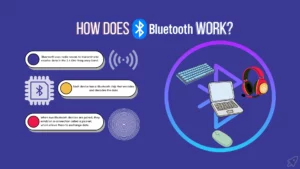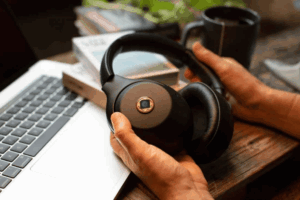Whether you’re pacing a long trail run, gearing up for your next jiu-jitsu roll, or locking in for a surf session, chances are you’ve got one key piece of gear dialed in: your headphones. Bluetooth earbuds and wireless devices have become as standard for athletes as the right shoes or board wax. They offer the perfect pump-up playlist, freedom from cords, and seamless integration with your training flow.
But for all their convenience, there’s a rising tide of questions – not from the mainstream sports world, but from researchers, holistic health circles, and independent athletes who’ve learned to question everything. The concern? Your go-to headphones might be quietly undermining your health and performance by exposing you to a constant stream of electromagnetic fields (EMFs).
Let’s dig into the science, the unknowns, and what you can do to stay ahead of the curve – without throwing your tech in the trash.
What Even Is Bluetooth?
Bluetooth is a type of wireless communication technology that allows devices to connect over short distances. It works using low-power microwave frequency signals – typically in the 2.4 GHz range. That’s the same neighborhood as Wi-Fi and some cordless phones.

Because Bluetooth is “low energy,” it’s often brushed off as harmless. But unlike cell phones or laptops that stay at a slight distance, Bluetooth headphones rest directly against your skull, often for hours each day.
It’s the difference between walking past a campfire and getting smoke blown in your face for hours at a time.
What the Science (and Silence) Says About EMFs
Electromagnetic fields are a form of radiation, and their biological impact is determined by frequency, intensity, proximity, and duration. Bluetooth falls under the category of non-ionizing radiation, meaning it doesn’t directly break DNA strands like X-rays or gamma rays do. But that doesn’t mean it’s safe, especially not with chronic, close-range exposure.
Multiple animal studies suggest EMFs can affect everything from oxidative stress levels to neurotransmitter balance. Some human studies have shown potential links between EMF exposure and altered brain function, changes in sleep quality, and even fertility issues. The International Agency for Research on Cancer (IARC) has classified radiofrequency EMFs as “possibly carcinogenic to humans.”
What’s striking is how little we know about the long-term effects of Bluetooth headphones, especially when they’re used for 2–4 hours daily or more. Most safety studies focus on phones or cell towers, not on constant, near-the-brain exposure from wireless earbuds.
The Lawsuit That Changed the Game: EHT vs. FCC
Here’s where things get even more real: in 2021, a major lawsuit – Environmental Health Trust (EHT) v. Federal Communications Commission (FCC) – resulted in a groundbreaking win for public health advocates.
The D.C. Court of Appeals ruled that the FCC had failed to properly review evidence of potential health harms from wireless radiation when it decided to uphold its 1996 safety limits – limits established before smartphones, Wi-Fi, or Bluetooth were a common thing.
The judges found the FCC’s decision to ignore over 11,000 pages of peer-reviewed research and public comment arbitrary and capricious. This includes evidence of neurological damage, oxidative stress, cancer associations, and impacts on children’s development.

So when someone tells you “there’s no evidence” that EMFs pose a risk, understand: there’s evidence – but the regulatory bodies aren’t acknowledging it. That’s a pretty important distinction.
If you’re an athlete who is already on the tip of challenging conventional practices – rejecting standard diets, rest protocols, and outdated training methods – this is just one more layer to stay ahead of the curve on.
What This Could Mean for Athletes
As an independent athlete, your performance is your feedback loop. You’re not hiding behind a team. When you start feeling off – foggy, anxious, overstimulated – it shows in your timing, your reactions, your focus. If EMFs are even slightly disruptive to cognitive clarity, hormonal regulation, or recovery, that’s a problem.
Some athletes report:
- Increased brain fog after long headphone sessions.
- Irritability or anxiety without knowing why.
- Delayed recovery, poor sleep, or lowered stamina.
Now, are Bluetooth headphones the cause of these issues? Not necessarily. But they’re one more stressor in an already stimulus-saturated world. Combine them with poor sleep, constant phone use, high training loads, and screen time, and you’ve got a perfect storm for chronic sympathetic nervous system overdrive.
When Wireless Becomes a Lifestyle
The average user isn’t just wearing Bluetooth headphones to train. They’re:
- Listening to podcasts while cooking.

- Taking calls with earbuds in all day, usually training with them too.
- Sleeping with Bluetooth sleep masks or headbands.
- Wearing fitness trackers or smartwatches 24/7.
What started as a training tool becomes a 16-hour EMF bath. The scary part? Most athletes won’t connect the dots until burnout hits, or worse, in hindsight, when we look back on EMFs like we look back on doctor-approved cigarettes.
It’s the cumulative load that matters. The more low-dose stressors your body has to adapt to, the less energy is left for performance, recovery, or growth.
So What Can You Do Without Going Full Tin-Foil?
This isn’t about fear. It’s about awareness and controlling what you can. You don’t need to ditch your headphones entirely. You just need to be strategic. Here’s what that looks like:
- Switch to wired when you’re training solo or meditating.
- Limit duration – no more 6-hour headphone marathons.
- Avoid sleeping with Bluetooth anything near your head.
- Use speakers or open-air playback when in private or solo.
- Cycle your exposure – give your body “off” time from devices.
- Practice earthing or grounding after tech-heavy days to rebalance.
Think of it like nutrition: you wouldn’t eat the same food every meal, every day. Why treat tech exposure differently?
Aires: Proven Protection for Performance-Minded Athletes
For athletes who rely on tech but don’t want to gamble with their health,

Aires offers a high-integrity solution. Their products aren’t just speculative – they’re rooted in measurable, physiological outcomes.
In recent testing conducted with UFC fighters, Aires devices were put to the test using EEG technology to measure brainwave coherence and neural efficiency. The results? Athletes experienced up to a half-second faster reaction time while using Aires devices — a massive gain in high-stakes sports where every millisecond counts.
This isn’t about placebo or hype. It’s about tuning the body’s electrical environment for sharper performance, cleaner recovery, and a more adaptive nervous system.
Unlike clunky EMF blockers or gimmicky stickers, Aires’ patented tech harmonizes the chaotic frequencies emitted by modern devices, reducing biological stress while letting your Bluetooth and phone still function as intended.
Just toss one in your gym bag, wear it on your phone, or clip it near your gear. For solo athletes who are already training smarter, eating smarter, and sleeping smarter – this is the next edge.
Take Control of Your Health
At the end of the day, no one knows your body like you do. Solo athletes are often their own coach, therapist, strategist, and recovery specialist. Tuning into EMFs is just another piece of the puzzle – one that’s rarely discussed but increasingly relevant in our hyper-connected world.
You don’t have to fear your tech. Just use it wisely. Test. Track. Adjust.
Because staying locked in doesn’t have to mean burning yourself out.








